Province Geology and Petroleum Occurrence
Total Petroleum System: Carboniferous-Rotliegend (403601)
Assessment Unit: Southern Permian Basin-Offshore (40360103)
Assessment Unit: Southern Permian Basin-Europe Onshore (40360102)
Assessment Unit: Southern Permian Basin-U.K. Onshore (40360101)
Undiscovered Gas Resources of the Carboniferous-Rotliegend Total Petroleum ...
Figure 1.Provinces, coastlines, and national boundaries associated with the...
Figure 2.Prominent oil and gas fields of the southern North Sea and adjacen...
Figure 3.Carboniferous-Rotliegend Total Petroleum System with center point ...
Figure 4.Southern Permian Basin-Offshore Assessment Unit (40360103) boundar...
Figure 5.Southern Permian Basin-Europe Onshore Assessment Unit (40360102) b...
Figure 6.Southern Permian Basin-U.K. Onshore Assessment Unit (40360101) bou...
Figure 7.Some structural features of the southern North Sea and adjacent ar...
Figure 8.Events chart for the Carboniferous-Rotliegend Total Petroleum Syst...
Figure 9.Late Carboniferous Variscan orogenic front, and the distribution o...
Figure 10.Stratigraphic column of the southern Permian Basin (modified from...
Figure 11.Comparison of published burial curves for Carboniferous-age rocks...
Table 1. Carboniferous-Rotliegend Total Petroleum System (403601), Assessment Results...
This report was prepared as part of the World Energy Project of the U.S. Geological Survey. In the project, the world was divided into 8 regions and 937 geologic provinces, and the provinces were then ranked according to the discovered oil and gas volumes within each (Klett and others, 1997). Of these, 76 priority provinces (exclusive of the U.S. and chosen for their high ranking) and 26 emerging (boutique) provinces (exclusive of the U.S. and chosen for their anticipated petroleum richness or special regional economic importance) were selected for appraisal of oil and gas resources. The petroleum geology of these priority and boutique provinces is described in this series of reports. A detailed report containing the assessment results is available separately (U.S. Geological Survey Assessment Team, 2000).
The purpose of the World Energy Project is to aid in assessing the quantities of oil, gas, and natural gas liquids that have the potential to be added to reserves within the next 30 years. These potential resources reside either in undiscovered fields whose sizes exceed the stated minimum field-size (in this case one million barrels of oil equivalent) or they occur as potential reserve growth of fields already discovered.
The total petroleum system (TPS) is the basic geologic unit of the World Energy Project. The TPS includes all genetically related shows and accumulations of petroleum (discovered and undiscovered) that (1) have been generated by a pod or by closely related pods of mature source rock, and (2) exist within a limited mappable geologic space. The petroleum system concept is modified from Magoon and Dow (1994). The minimum petroleum system is defined as that part of a total petroleum system encompassing discovered shows and accumulations together with the geologic space in which the various essential elements of the system (source, reservoir, seal, and overburden rocks) have been proved by these discoveries.
An assessment unit (AU) is a mappable part of a total petroleum system in which discovered and undiscovered fields constitute a single relatively homogenous population such that the chosen methodology of resource assessment based on estimation of the number and sizes of undiscovered fields is applicable. A TPS might equate to a single AU or, if necessary, a TPS may be subdivided into two or more AUs such that each is sufficiently homogeneous in terms of geology, exploration history, and risk to be assessed individually. Assessment units are considered to be: (1) established units if they contain more than 13 fields, (2) frontier units if they contain 1 – 13 fields, or (3) hypothetical units if there are no discovered fields.
A graphical depiction of the elements of a total petroleum system is provided in the form of an events chart, which shows the time of deposition of essential rock units and the timing of processes, such as trap formation, necessary for the accumulation of hydrocarbons.
A unique eight-digit numeric code identifies each AU with respect to the region, province, and TPS. For example, the Southern Permian Basin-Offshore AU was assigned number 40360103. The first digit is the region number, indicating the AU is in Europe (Region 4). The next three digits uniquely identify the province; in this case the Anglo-Dutch Basin is number 036. The following two digits, 01, refer to the TPS, and the final two digits are the unique AU number (03 in this example).
The codes for the regions and provinces were established and listed by Klett and others (1997); provinces for Europe (Region 4) are shown and listed in greater detail in USGS Digital Data Series DDS-60, the principal publication of the World Petroleum Assessment 2000 (U.S. Geological Survey Assessment Team, 2000). Oil and gas reserves quoted in this report are derived from Petroleum Exploration and Production database (Petroconsultants, 1996) and other area reports from Petroconsultants, Inc., unless otherwise noted.
Figures in this report that show boundaries of the total petroleum systems, assessment units, and pods of active source rocks were compiled using geographic information system (GIS) software. Political boundaries and cartographic representations were taken, with permission, from Environmental Systems Research Institute
The Anglo-Dutch Basin and the Northwest German Basin are two of the 76 priority basins assessed by the U.S. Geological Survey World Energy Project. The basins were assessed together because most of the resources occur within a single petroleum system (the Carboniferous-Rotliegend Total Petroleum System) that transcends the combined Anglo-Dutch Basin and Northwest German Basin boundary. The juxtaposition of thermally mature coals and carbonaceous shales of the Carboniferous Coal Measures (source rock), sandstones of the Rotliegend sedimentary systems (reservoir rock), and the Zechstein evaporites (seal) define the total petroleum system (TPS). Three assessment units were defined, based upon technological and geographic (rather than geological) criteria, that subdivide the Carboniferous-Rotliegend Total Petroleum System. These assessment units are (1) the Southern Permian Basin-Offshore Europe Assessment Unit, (2) the Southern Permian Basin Onshore Europe Assessment Unit, and (3) the Southern Permian Basin Onshore United Kingdom Assessment Unit. Although the Carboniferous-Rotliegend Total Petroleum System is one of the most intensely explored volumes of rock in the world, potential remains for undiscovered resources. Undiscovered conventional resources associated with the TPS range from 22 to 184 million barrels of oil, and from 3.6 to 14.9 trillion cubic feet of natural gas. Of these amounts, approximately 62 million barrels of oil and 13 trillion cubic feet of gas are expected in offshore areas, and 26 million barrels of oil and 1.9 trillion cubic feet of gas are predicted in onshore areas.
The Northwest German Basin and the Anglo-Dutch Basin of northern Europe (U.S. Geological Survey World Energy Project provinces 4036 and 4035, respectively) are two of the 76 World Energy Project priority provinces. The Northwest German Basin is number 21 and the Anglo-Dutch Basin is number 39 in the World Energy Project global ranking (Klett and others, 1997). These basins share common boundaries with the North Sea Graben Province (number 4025), which ranks number 8 in the world. Taken together, these three provinces account for the vast majority of oil and gas resources known in Western Europe. The location and boundaries of these provinces are shown in figure 1.
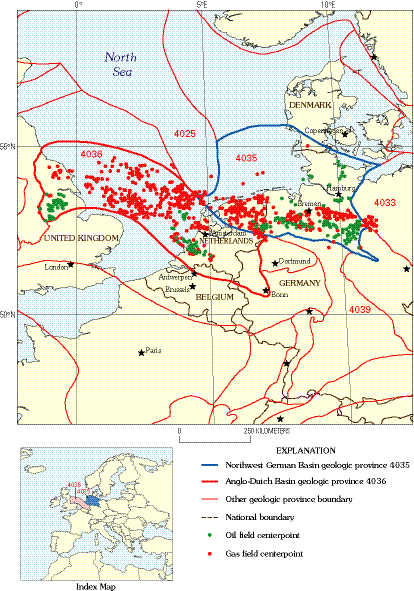
In contrast to the oil-prone North Sea Graben, the Anglo-Dutch and Northwest German Basins are gas-prone. The Groningen gas field, located just onshore in the Netherlands (fig. 2), is the largest hydrocarbon accumulation in the Northwest German Basin and one of the largest gas fields in the world. Groningen contains approximately 100 trillion cubic feet (TCF) of produced or proved reserves of natural gas. The largest field in the Anglo-Dutch Basin is the Leman field, in the United Kingdom continental shelf (fig. 2), which accounts for approximately 12 TCF of produced and proven gas reserves.
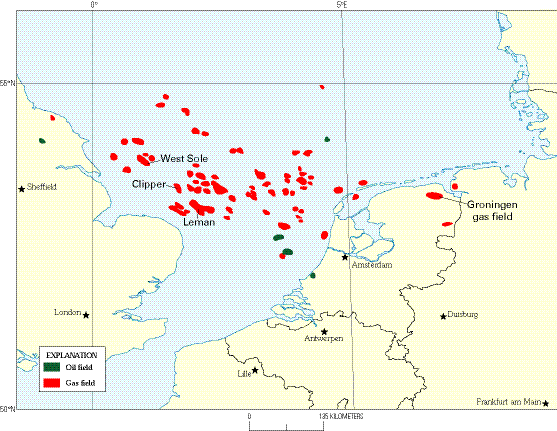
Figure 2.Prominent oil and gas fields of the southern North Sea and adjacent onshore areas.
The Northwest German Basin and the Anglo-Dutch Basin were combined for the purposes of the petroleum resource assessment. This lumping was considered justifiable because the basins are contiguous and because most of the natural gas in these provinces has been generated and entrapped within a single total petroleum system (TPS), referred to as the Carboniferous-Rotliegend TPS. Geographically, it occupies most of the Anglo-Dutch Basin and the Northwest German Basin as well as parts of the adjacent North Sea Graben and Polish-German Basin provinces (fig. 3). The Carboniferous-Rotliegend was the only TPS assessed in the Anglo-Dutch and Northwest German Basins, even though other geologically interesting but less economically important petroleum systems are present (Kockel, Wehner and Gerling, 1994; Fraser and others, 1990). The Carboniferous-Rotliegend TPS was subdivided into three assessment units, based largely on economics, accessibility, and exploration history; these are Southern North Sea Offshore (AU40360103, fig. 4), Europe Onshore (AU40360102, fig. 5), and United Kingdom Onshore (AU40360101, fig. 6).
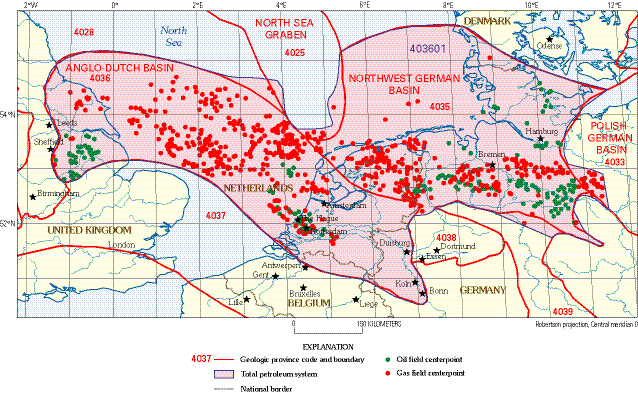
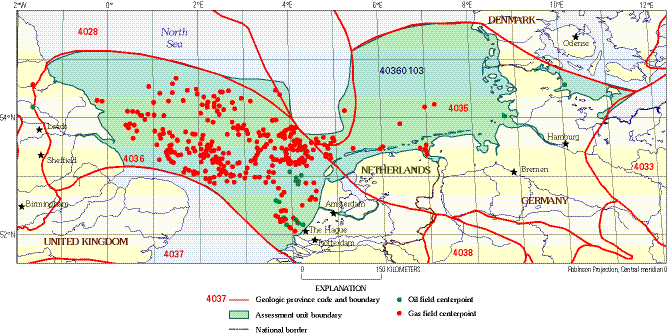
Figure 4.Southern Permian Basin-Offshore Assessment Unit (40360103) boundary.
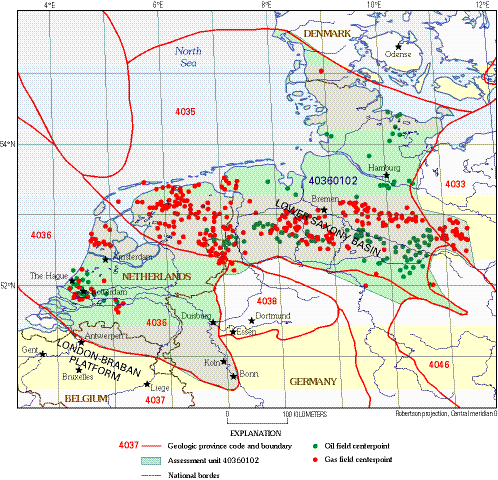
Figure 5.Southern Permian Basin-Europe Onshore Assessment Unit (40360102) boundary.

Figure 6.Southern Permian Basin-U.K. Onshore Assessment Unit (40360101) boundary.
The Anglo-Dutch Basin and the Northwest German Basin geologic provinces are contiguous regions (fig. 1) that include onshore and offshore areas of Belgium, Denmark, France, Germany, United Kingdom, and the Netherlands. The Anglo-Dutch Basin contains a number of smaller sub-basins, including the Sole Pit Basin (also referred to as the Sole Pit High, as the basin was the site of a tectonic inversion), East Midlands Shelf, West Netherlands, Broad Fourteens, and Central Netherlands sub-basins (fig. 7). The Northwest German Basin is also a compound basin, including the Lower Saxony Basin (fig. 7). The two provinces are bounded on the southwest and south by the London-Brabant Platform and the Rhenish Massif, on the north and northwest by the Mid-North Sea High, the Central Graben, the Ringkobing-Fyn High, and the Horn Graben (fig. 7). The provinces are bounded on the east by a structurally positive saddle near the Polish-German border, on trend with the northeast-striking Hesse Depression (Ziegler, 1990), which is not shown on figure 7.
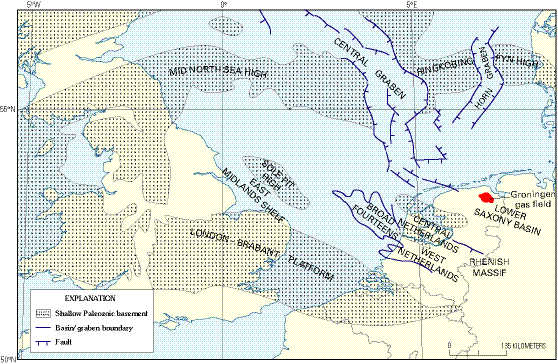
Figure 7.Some structural features of the southern North Sea and adjacent areas.
The elements giving rise to petroleum generation and accumulation in the Carboniferous-Rotliegend TPS are largely the result of structural and sedimentary events that took place during Carboniferous and Permian time (fig. 8). Particularly important is the juxtaposition of the western part of the Southern Rotliegend sedimentary basin and related Zechstein evaporite deposits on the Late Carboniferous Variscan foreland basin (fig. 9).
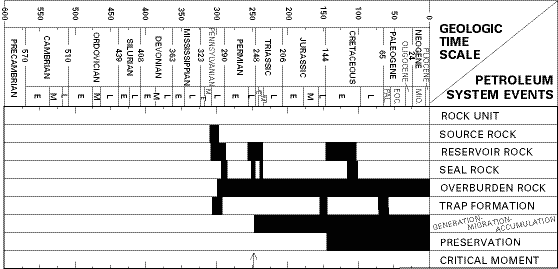
Figure 8.Events chart for the Carboniferous-Rotliegend Total Petroleum System.
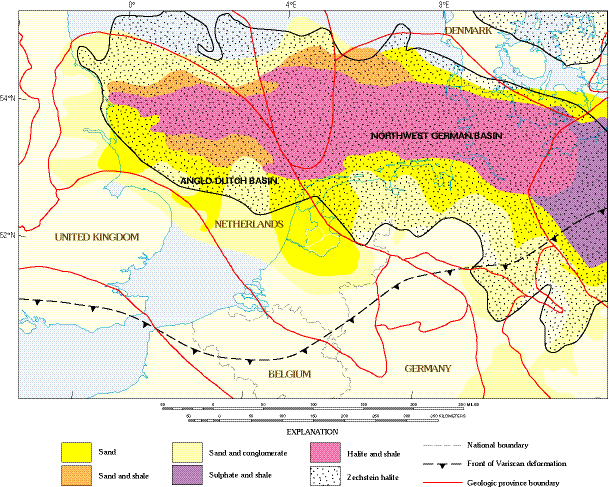
The Variscan foreland is a downward flexure, caused by tectonic loading north of the active Variscan orogenic belt that formed as African Gondwana collided with European Laurasia during the final stages (Visean to Westphalian) of the assembly of the Pangaea supercontinent. The earliest Variscan deformation probably occurred to the south of the foreland in the Late Devonian. Deformation progressed northward during the Early Carboniferous as a back-arc seaway (the Rheno-Her-cynian Basin) was first closed and then deformed into a series of complex thrust/nappe pairs. The northernmost (and latest) Variscan deformation occurred during the Late Carboniferous and was soon followed by eruption of the Lower Rotliegend Volcanics (Ziegler, 1990). Tectonic relaxation of the foreland and Late Carboniferous tectonic inversion are represented in the stratigraphic record by a major unconformity at the base of the Upper Rotliegend (Glennie, 1998; Gast, 1993) (fig. 10).
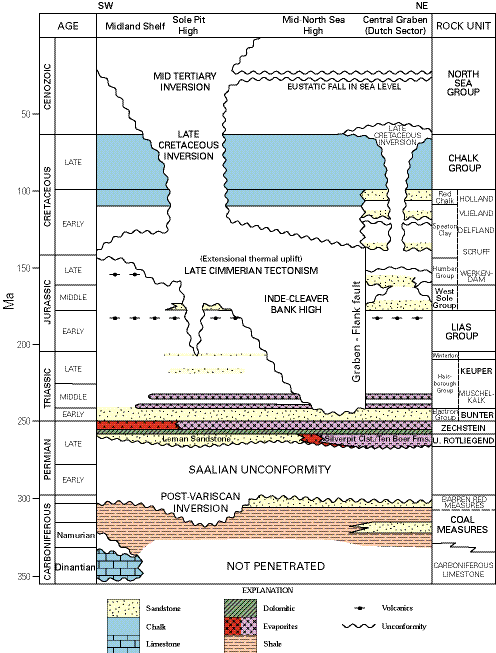
Figure 10.Stratigraphic column of the southern Permian Basin (modified from Glennie, 1997a).
The rapidly subsiding Variscan foreland accommodated as much as 9,000 m of nonmarine sedimentary rocks of Westphalian age, collectively called the Coal Measures (Collinson and others, 1993), that accumulated at tropical latitudes with luxuriant vegetation in a variety of depositional settings within extensive fluvial systems. In northwestern continental Europe and the southern North Sea, these fluvial systems generally flowed northward, whereas in the British Isles and the central North Sea, fluvial systems were southward flowing (Ramsbottom and others, 1978; Ziegler, 1990). Coals and carbonaceous shales in the fluvial sequences are thought to be the source rocks for natural gas in the Carboniferous-Rotliegend TPS (Cornford, 1998).
Permian sedimentary rocks record profound changes in climate, vegetation, and sedimentary processes in the Variscan foreland. A decrease in the rate of erosion of the adjacent highlands and northward drift of Pangaea into arid latitudes resulted in declining sediment supply and continuous desertification (Ziegler, 1990). In the Southern Permian Basin, which trends east-west between the northeast coast of England across the southern North Sea and into northernmost Germany and southern Denmark, continental desert sedimentary sequences, collectively constituting the Rotliegend, were deposited at the site of the old foreland basin (Glennie, 1998). Alluvial fans and braid-plain deposits that accumulated near the Variscan front grade northward into eolian and fluvial (wadi) facies, and, farther north, to sabkha and desert-lake evaporites and shales such as the Silverpit Claystone Formation (fig. 10) (George and Berry, 1997).
The end of Permian glaciation caused global sea level rise and marine transgression across the Rotliegend desert. The Zechstein sea expanded into the Southern Permian Basin from the north, probably flowing along pre-existing Proto-Atlantic and Proto-North Sea fracture systems. The basin is believed to have lain below sea level prior to the Permian Zechstein transgression, and the scouring, reworking, and soft-sediment deformation seen in the uppermost Rotliegend is consistent with speedy filling of the basin (Glennie, 1990; 1998). Organic carbon-rich mud of the Kupferschiefer (Copper Shale) draped desert sediments and basal Zechstein lag deposits. High evapo-transpiration rates in conjunction with restricted flow caused persistent evaporite accumulation. The resulting Zechstein Group consists of thick carbonate and evaporite rocks that are largely of Late Permian age (Taylor, 1998). The Zechstein is present throughout the southern North Sea and onshore areas of northwestern Europe, especially in England, Denmark, the Netherlands, Germany, Poland, and Lithuania. Zechstein evaporites occupy two sub-basins, the southern one of which coincides with the boundaries of the Carboniferous-Rotliegend TPS, wherein the Zechstein is more than 2,000 m thick.
In the southern North Sea and on the continent, the Zechstein is characterized by four major (Z1, Z2, Z3, Z4) and one or more minor cycles of evaporite deposition. The ideal cycle, reflecting increasing evaporation and salinity through time, consists of (1) a thin basal clastic deposit, (2) a middle limestone, dolomite, anhydrite, and halite sequence, and (3) an upper unit of bittern salts of magnesium and potassium. Each successive cycle is more evaporitic than the previous one, and there is an inverse correspondence between areal distribution of evaporite facies and intensity of evaporation (Tucker, 1991); for example, carbonate rocks are much more extensive than halite or bittern salts.
A deep basin model has been popular among geologists studying the German Zechstein for many years, but lithologic and stratigraphic relations in the southern North Sea Basin seem to require additional constraints. In particular, the large volumes of evaporites indicate continual or episodic influx of marine water, as might result from the presence of a sill that separated the evaporite basin from its water source. Close examination of various Zechstein cores and outcrops seems to indicate episodes of partial to complete desiccation of the Zechstein basin (Tucker, 1991; Kiersnowski and others, 1995).
Carbonate rocks form platform and slope facies that bound the margins of the first three evaporite cycles (Z1–Z3). Such carbonates can locally form reservoir rocks, but they do not serve as seals to gas accumulations in underlying Rotliegend reservoirs. Some basin-center carbonate rocks, however, have low porosities and permeabilities and are effective parts of the seal-rock system. Thick halite beds are prominent in the second Zechstein cycle (the Z2 beds), which, in addition to providing tight seals, are the main salts involved in the diapiric movements that have influenced oil entrapment in the southern and central North Sea (Schultz-Ela and Jackson, 1996).
Over a wide area of the southern North Sea, and adjacent onshore areas of Europe and England, hydrocarbons are predominantly found associated with the same source rocks (Carboniferous Coal Measures), reservoir rocks (Permian Rotliegend sandstones), and evaporite seals (Zechstein) that combine to form the Carboniferous-Rotliegend TPS. The southern boundary of the TPS is determined by the northern edge of the old Variscan deformed zone. The northern, eastern, and western boundaries are near the approximate limit of the evaporite facies of the Zechstein (fig. 9). This single petroleum system accounts for most hydrocarbon accumulations in this area and forms the basis for resource assessment.
The geographic area encompassed by the Carboniferous-Rotliegend TPS became the site of one of the world’s first oil developments when production began in Lower Saxony in 1858 (Kockel and others, 1994). Although this development established hydrocarbon production in the area, the Lower Saxony oil is not geologically part of the Carboniferous-Rotliegend TPS but instead was generated from Mesozoic source rocks such as the Posidonia Shale (not shown in figure 10).
The defining event in the development of the Carboniferous-Rotliegend TPS occurred in 1959, when a wildcat well (the Slochtern-1) discovered a gas-bearing Rotliegend sandstone 180 m thick. Seismic exploration and additional drilling identified a large, gas-bearing structure (Stauble and Milius, 1970) that became known as the Groningen field (figs. 2, 7). It was initially estimated to contain about 58 trillion cubic feet (TCF) of natural gas, but subsequent work has increased the estimated recoverable resources to about 100 TCF (Glennie, 1997a). The discovery of this prolific gas field changed the energy landscape of Europe; in a region where every town previously relied on coal, or had its local town-gas facility, gas was delivered via pipeline from the Groningen field.
Original work by K.W. Glennie and others at Royal Dutch Shell (Glennie, 1970, 1972) led to the interpretation of the Rotliegend reservoirs as eolian deposits and identified the source rock as Carboniferous Coal Measures. The investigations also indicated the possible existence of gas accumulations offshore, with the result that exploratory drilling in the United Kingdom sector of the North Sea was undertaken in 1964. After a few unsuccessful wells, the West Sole gas field (fig. 2) was discovered in late 1965, confirming the facies model and exploration concept. This initial discovery was followed closely by a string of successes that pursued the Carboniferous-Rotliegend play model through large structural closures in the southern North Sea (Brennand and others, 1998).
By 1969, the large discoveries saturated the United Kingdom gas market, which at that time was managed as a monopoly by the British Gas Council (later British Gas), and led to a dramatic downturn in drilling during the 1970s. Exploration companies then turned north to explore for oil in the central and northern North Sea. However, in 1981, fearing a national gas shortage, British Gas raised the price for new gas, starting a renewed pattern of discovery and development that continues to the present. As of 1997, 290 gas fields had been discovered offshore in the southern North Sea, accounting for approximately 75 TCF of recoverable natural gas and more than 400 million barrels of oil (MMBO). Onshore in the Netherlands and Germany, more than 229 gas fields had been discovered accounting for about 150 TCF of gas, as well as some oil and natural gas liquids.
Coals and carbonaceous shales of the Westphalian-age (Carboniferous) Coal Measures (fig. 10) are believed to be the principal source rocks for gas accumulations in the southern North Sea and adjacent areas (fig. 2) (Cornford, 1998). By even conservative estimates, the generative capacity of the Coal Measures is considered to far exceed the amount of gas presently discovered (Barnard and Cooper, 1983; Cornford, 1998).
Although complex in detail, the Coal Measures in general consist of upward-coarsening deltaic rocks that are overlain by fluvial deposits and associated coals. The fluvial rocks include conglomeratic, complexly stacked sandstones attributed to deposition in major braided stream systems. Within the bounds of the Carboniferous-Rotliegend TPS, the Coal Measures are probably 1,000 to 3,000 m thick (Leeder and Hardman, 1990), although reliable estimates are difficult to make. Elsewhere the Carboniferous can be much thicker. Coal seams account for about 3 percent of the total stratigraphic sequences (Lutz and others, 1975), and carbonaceous shales account for a much larger percentage (Cornford, 1998).
Westphalian coals and carbonaceous shales are dominated by type III kerogen, which is rich in vitrinite derived from terrestrial plant tissues, and in charcoal (inertinite) (Cornford, 1998). Such humic kerogen displays hydrogen/carbon ratios of 1.0 to 0.5 and oxygen/carbon ratios of 0.4 to 0.02, both of which decline as time-temperature exposure increases (Hunt, 1995).
According to Cornford (1998) and Bernard and Cooper (1983), relatively little information concerning gas composition in the southern North Sea has been publicly released. In any case, correlation of natural gases to particular source rocks is difficult. Generally, gases of the Carboniferous-Rotliegend TPS are reported to be sweet, dry gas with carbon isotopic compositions consistent with derivation from strata of the Coal Measures (-22 to -28o/oo, PDB for gases, compared with -22 to -25o/oo, PDB for kerogen). Regional trends in carbon dioxide and nitrogen content have been reported (Boigk and Stahl, 1970; Boigk, 1981; Kettel, 1982, 1989; Krooss and others, 1995); the most significant trend being an increase in nitrogen content eastward from the northern Netherlands and Groningen, where nitrogen content is about 4 percent and about 15 percent, respectively, into Germany and Poland where nitrogen is so abundant that the gas is considered uneconomic. Kettel (1982, 1989) and Krooss and others (1993, 1995) have argued that such a trend reflects the increasing contribution of late-stage gas generation from the most thermally mature terrigenous source rocks.
Carboniferous strata in the undeformed foreland basin north of the Variscan highlands emerged from the Paleozoic without having been buried sufficiently for maximum gas generation (fig. 11). Within the deformed zone, south of the Variscan front (fig. 9), most Carboniferous rocks have been metamorphosed to at least greenschist facies, and kerogen has been overly mature with respect to maximum gas generation since the Late Carboniferous. Onshore in northwestern Europe, rank of Westphalian coal ranges from subbituminous to meta-anthracite, corresponding to vitrinite reflectance values of 1 to 3 percent (Cornford, 1998).
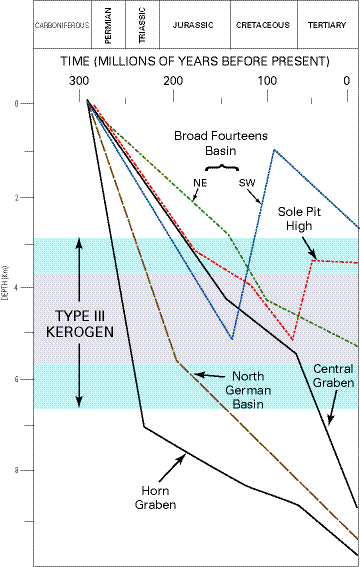
North of the Variscan front (fig. 9), post-Paleozoic burial of Coal Measures strata has occurred to various degrees from the Triassic to the present day. However, the burial history has differed considerably from place to place (fig. 11). Several areas of post-Carboniferous gas generation have been identified based upon lithology, kerogen content, and reconstructed burial and time-temperature history. In the southern North Sea these areas include the Sole Pit High, the West Netherlands and Broad Fourteens Basins, and northern Germany-southern Denmark (Fig. 7).
In the Sole Pit High, the Coal Measures were rapidly buried from the time of deposition until the end of the Cretaceous, when they had reached depths as great as 4,000 m (Cornford, 1998). The burial depths are indicated by stratigraphic reconstruction, sonic velocity, fission track analysis, and measured vitrinite reflectance values ranging from about 1 percent near the basin margin to nearly 3 percent near the basin axis (Cornford, 1998; Glennie and Boegner, 1981). These data have been interpreted to indicate that at least one and possibly two episodes of gas generation and migration from the basin center to basin-flanking traps occurred between Early Jurassic and Late Cretaceous time. Thinning and onlap of the Chalk Group onto the Sole Pit High (fig. 7) indicate a Late Cretaceous inversion from a structural low to a structural high. This inversion is believed to have caused remigration of gas, making structural interpretation of gas accumulations and thermal maturity difficult (Green and others, 1995). Another inversion of the Sole Pit Basin during the Tertiary evidently resulted in erosion or non-deposition of pre-Miocene rocks (Glennie, 1997a; Alberts and Underhill, 1991). Similar two-stage inversions also occurred in the West Netherlands Basin and in the Broad Fourteens Basin, although the Late Cretaceous inversion was relatively stronger in those basins than in the Sole Pit High, where the Tertiary inversion seems to have had greater effect (Cornford, 1998).
Areas of deep burial and subsequent inversion, such as the Sole Pit High and the West Netherlands Basin, are probably the sites of gas generation for the gas fields in the southern North Sea. In the Coal Measures, most gas generation occurred at vitrinite reflectance values of 1 to 3 percent, corresponding to the Middle Jurassic in the Sole Pit High and Broad Fourteens Basin (fig. 11) and only slightly later in the Central Netherlands Basin (Cornford, 1998). The timing of generation is estimated from burial history modeling and from K/Ar ages of diagenetic illite in gas-bearing sandstone reservoirs of the Rotliegend (Hamilton and others, 1989). In the vicinity of the Sole Pit, gas migration is believed to have occurred after 158±18.6 Ma (Robinson and others, 1993). In the Broad Fourteens, gas entered the reservoirs after 140 Ma.
Most of the natural gas entrapped onshore, especially that of the Groningen field, is believed to have been generated in northern Germany and southern Denmark, but possibly also just offshore in the West Netherlands Basin (fig. 7). Additional onshore gas generation may have taken place as a result of contact metamorphism (Glennie, 1986). K/Ar studies of authigenic illite in the Rotliegend reservoirs of the Groningen field indicate the structure was progressively filled over a period of about 30 million years. Natural gas entrapped onshore in the southern United Kingdom was probably also generated from Carboniferous strata, although specific source rocks and generation sites are not well known.
In the Carboniferous strata of northeastern England, the coals and shales constitute two distinct source rock components, with the coals containing approximately 60 percent total organic carbon (TOC) and type III kerogen, whereas the shales have approximately 1 percent TOC and mixed type II and type III kerogen. Marine shales range from less than one percent to several percent TOC, mostly in type II kerogen. Oil accumulations are directly related to the presence of prodelta marine shales with type II kerogen. Source rocks became mature for oil and other liquids as early as the Late Carboniferous in some areas. Although these diverse Carboniferous source rocks were included in the World Energy Assessment (U.S. Geological Survey Assessment Team, 2000) of this area, at least the oil-prone shales are considered to constitute a separate petroleum system.
Sandstones of the Rotliegend are the predominant reservoirs of the Carboniferous-Rotliegend TPS, accounting for more than 85 percent of the discovered gas accumulations in the offshore and virtually all of the gas in the giant Groningen field onshore in the Netherlands. In addition, these sandstones have significant potential for undiscovered small accumulations offshore and for further growth of reserves in existing fields. However, much of the undiscovered natural gas in the southern North Sea may occur in sandstones of the Coal Measures, adjacent to the carbonaceous source rocks, and in the overlying Bunter Sandstone (fig. 10).
Based upon the work of Glennie (1970, 1972) and many others, the Rotliegend sandstones have been attributed to deposition in a variety of arid, terrestrial environments. Dominant among these are ephemeral fluvial (wadi) systems, various types of eolian deposits, desert-lake environments, and adjacent sabkhas. According to Glennie (1998), in the southern North Sea and adjacent onshore areas of the Netherlands, Rotliegend facies representing these depositional environments are systematically arranged areally from south to north and stratigraphically from bottom to top. The lowest and southernmost sandstones and gravels of wadi and eolian origin give way northward and upward to successive accumulations of eolian sandstone, sabkha deposits, and desert-lake sedimentary sequences.
Reservoir quality is strongly influenced by the depositional environments of the Rotliegend. Most commercial gas accumulations are found in eolian dune deposits, with some production coming from fluvial facies. Those sandstones with the cleanest, best porosity at the time of deposition, and those sandstones deposited away from the water table tend to display the best preservation of porosity and permeability. Eolian facies of all types generally make better reservoirs than do interdune deposits, laterally adjacent wadi and sheet flood deposits, or any other fluvial, alluvial, or sabkha rocks. The best reservoirs are thus commonly found in the middle of the Rotliegend, within which eolian facies predominate (George and Berry, 1993; 1997). However, considerable variation in reservoir quality exists within the eolian facies. Compared to horizontally stratified, finely laminated ripple strata of the dune bases and tops, the more steeply dipping foreset beds, consisting of avalanche and grainfall strata, tend to be initially less compacted and to be less affected by burial diagenesis (Glennie and others, 1978).
Diagenesis is a problem for reservoir quality in the Rotliegend. Fluvial sandstones are commonly so extensively altered by diagenetic processes as to render them noncommercial for hydrocarbon production (Glennie and others, 1978). Effects of compaction, pressure solution, and precipitation of chlorite all negatively impact the porosity and permeability of Rotliegend reservoirs. However, the most damaging diagenetic effect is the precipitation of fibrous illite in sandstones that had already undergone significant porosity reduction (Ziegler, 1992). Successful gas production of illitized reservoirs is only possible where there has been natural fracturing, such as the inversion fractures observed at Clipper or West Sole fields (fig. 2), or where directional drilling and expensive reservoir engineering is employed (Glennie, 1998).
Evaporite deposits of the sabkha and desert-lake sequences of the Rotliegend may seal gas accumulations in underlying Carboniferous reservoirs, but the Zechstein salt is the seal for virtually all gas accumulations in Rotliegend reservoirs themselves. The near-perfect seal of the Zechstein is the main reason for the existence of the large gas fields of the Carboniferous-Rotliegend TPS. Radiometric ages of diagenetic illite in the reservoirs show that the Zechstein evaporites have effectively sealed gas in structural and stratigraphic traps for approximately 150 million years (Lee and others, 1985; Hamilton and others, 1989; Robinson and others, 1993). These observations are consistent with Klemme’s (1983) assertion that giant gas fields are in large structures that have highly effective seals.
Gas accumulations in Carboniferous reservoirs depend upon traps developed (1) wholly within the Carboniferous, (2) by lateral facies changes from sandstone or gravel to mudstone which occurs within the thick sequences of fluvially dominated rocks, and (3) by being sealed beneath the desert-lake evaporites of the Rotliegend (for example, Silverpit Claystone Formation). Gas-bearing structures found to date consist of Variscan-age folds and various Late Jurassic – Early Cretaceous and Late Cretaceous – early Tertiary uplifts. However, intraformational stratigraphic traps could also have developed where thermally mature coals or carbonaceous shales are in contact with the reservoirs.
Gas accumulations in Upper Permian Rotliegend strata depend upon the juxtaposition of mature Carboniferous source rocks, the Rotliegend sandstone or conglomeratic reservoir rocks, and the Zechstein evaporite seals. Effective gas trapping structures formed after deposition of the evaporite, but were of insufficient magnitude to breach the seal. These gas-filled structures date from the Late Jurassic to Early Cretaceous and from the Late Cretaceous to early Tertiary. In addition, transpression in the Tertiary caused localized basin inversions that also resulted in the development of gas-bearing structures. Diapiric movements of the Zechstein salt at various times in the burial history have also been responsible for primary gas-bearing structures and traps for remigrated gas.
The close relations and similar distribution patterns of Carboniferous source rocks, Rotliegend sandstone reservoirs, and Zechstein evaporites in gas fields led to the decision to consider the voluminous gas accumulations of the southern North Sea and adjacent onshore areas of Europe as forming a single petroleum system—the Carboniferous-Rotliegend TPS (AU403601, fig. 3). Division into assessment units was, however, based upon technological and geographic criteria rather than upon geological distinction. Three AUs were identified: (1) the Southern Permian Basin-Offshore Europe (AU40360103, fig. 4), (2) the Southern Permian Basin-Onshore Europe (AU40360102, fig. 5), and (3) Southern Permian Basin Onshore United Kingdom (AU40360101, fig. 6). Within the AUs, various geologic settings of hydrocarbon accumulation, informally referred to here as exploration plays, were considered for resource assessment purposes.
The Southern Permian Basin-Offshore AU coincides with the extent of the Carboniferous-Rotliegend TPS in the offshore area of the southern North Sea between England and the European continent (fig. 4). It is bounded on the south by the London Brabant Platform and on the north by the mid-North Sea high (fig. 7). Northwestern and southeastern boundaries, respectively, are the coastlines of England and the European continent (figs. 1, 7).
All of AU40360103 is predominantly the Rotliegend sandstone play, which has been the objective of intensive exploration since the beginning of offshore drilling. Over most of the area, the Coal Measures have provided abundant hydrocarbon charge in all settings and retain generative capacity even today. Likewise, Zechstein seal exists in almost all areas and seal integrity has been preserved, even in areas of intense deformation. Failures of charge are most commonly related to timing of structural inversion relative to gas generation or due to leakage in those few areas where the seals are thin. Seal quality also is locally inadequate where carbonate rocks supplant evaporite beds as a result of facies variation. Exploration uncertainties arise from poor reservoir quality where either the best eolian reservoir facies is absent, or where depth and facies-related diagenetic effects have reduced reservoir porosity and permeability. Identification of structural closures can be difficult, as Rotliegend closures are small compared to the thick and lithologically heterogeneous overburden.
The Rotliegend play is presently highly mature. Years of intense and expensive exploration drilling and a dense seismic grid appear to have identified most of the significant footwall closures. Nevertheless, discovery of progressively smaller fields continues and potential remains in limited hanging-wall traps, in known closures previously judged too small to warrant development, and in subtle stratigraphic traps that have thus far avoided detection.
Comparatively few wells have been drilled and few fields have been found in the Carboniferous, but the stratigraphic interval remains prospective because of its substantial gas generative capacity and complex lithologic variations. Various sandstones in valley fill sequences should be of acceptable reservoir quality, but the stratigraphic complexities that characterize this thick section of fluvio-deltaic rocks make for problems in the location of exploration targets. Compared to the quartzose Rotliegend reservoirs, the sandstones of the Carboniferous are mineralogically immature. Consequently, loss of reservoir quality from burial-related compaction and diagenesis may be the limiting factor in successful development of reservoir targets within the Carboniferous. So far, all Carboniferous discoveries have been in two structural settings—the Variscan folds and the post-Paleozoic structures reactivated during tectonic inversion. Traps are expected to result from lateral and vertical permeability barriers at the margins of discontinuous sandstones. The best seals are probably the Permian desert-lake evaporites such as the overlying Rotliegend Silverpit Claystone Formation (fig. 10).
The Carboniferous strata have considerable exploration potential in offshore settings, but technical problems involved with exploration have so far discouraged extensive drilling. The lateral and vertical variability of sedimentary facies, the difficulties in discerning gas-saturated rocks within the complex lithologies, and the paucity of reliable stratigraphic markers offshore combine to make fields in the Carboniferous difficult to exploit given current exploration technology and economics. Nevertheless, the Carboniferous is probably the most prospective stratigraphic interval remaining in the southern North Sea. Success will require the ability to overcome seismic imaging problems in order to identify thick channel sandstones that are gas-charged.
Shelf-edge and slope carbonate facies of the Zechstein are potential exploration targets. Oil-prone source rocks, such as the Kupferschiefer Shale, could provide a local charge, but the most likely potential would be realized where Zechstein carbonates are charged from the Carboniferous Coal Measures underlying the Rotliegend. Except for Z-1 carbonates, which are not separated from the Rotliegend by salt, this scenario requires that the near-perfect Zechstein seal be breached.
Although oil, gas, and condensate are produced from the Zechstein in Germany, Poland, and the Netherlands, where the source rock is the Stinkschiefer Shale, the Zechstein has never yielded much gas in offshore areas. Nevertheless, moderate to small stratigraphic traps for gas and possibly for Zechstein oil may be expected. Loss of reservoir quality in the carbonate facies adjacent to the evaporites, however, may substantially reduce the economic potential of these small traps.
Gas accumulations sourced from the Coal Measures have been discovered within the Triassic Bunter and Hewett Sandstones (fig. 10) in fault-bounded anticlines. Other possibilities for undiscovered accumulations include stratigraphically entrapped gas within the Bunter, as well as within the overlying Lower Cretaceous sandstones.
Obvious structures including Bunter and younger reservoirs have been tested, which leaves relatively subtle stratigraphic or structural traps as remaining exploration targets. An obvious negative aspect of this play is the Zechstein and Rotliegend seals, which are as effective in shielding these sandstones from a gas charge as they are at preventing leakage from Rotliegend and Carboniferous reservoirs. Potential exists for discovery of additional small accumulations, possibly in association with other traps.
The Carboniferous-Rotliegend TPS and the Southern Permian Basin-Europe Onshore AU coincide with the extent of thermally mature Westphalian (Coal Measures) source rocks and related gas and liquid accumulations in the onshore area on the European continent adjacent to the southern North Sea (fig. 5). Assessment Unit 40360102 is located mainly in the Netherlands and Germany, but also includes parts of Belgium and Denmark. It contains several sub-basins, including onshore areas of the West Netherlands Basin and the Lower Saxony sub-basins (fig. 7). The AU is bounded on the southwest and south by the London-Brabant Platform and by the Rhenish Massif, on the north and northwest by the North Sea and the Trans-European fault, and on the east, near the German border, by a structurally positive saddle on trend with the northeast-striking Hesse Depression (Ziegler, 1990). The boundary separating AU 4060103 and AU 4030102 is placed at the coastline because of the distinct differences in technology, economics, and regulations encountered in onshore versus offshore settings. Because the two assessment units share most formation boundaries, structural properties, and geologic history, the following description of exploration plays in the onshore assessment unit is necessarily abbreviated and somewhat redundant with play descriptions from the offshore assessment unit.
The prolific source rock capacity of the Carboniferous Coal Measures is present throughout the AU and can be relied upon to provide adequate hydrocarbon charge to fill structures, including fields as large as the giant Groningen gas field, to their spill-point (Lutz and others, 1975). Similarly, the effective seal of the overlying Zechstein carbonate-evaporite complex is present throughout the AU. All discovered Rotliegend fields are underlain by coals and carbonaceous shales of the Coal Measures and overlain by Zechstein evaporites.
The Rotliegend sandstone play has been extensively developed and is in a mature state of exploration. Potential for new discoveries is mainly in small structural traps, some of which have already been identified during exploratory studies but not drilled, and in subtle stratigraphic traps.
The prolific gas-prone source rocks of the Carboniferous Coal Measures, the abundance of closely associated channel sandstones and related valley-fill complexes, and the presence of shales and evaporitic rocks of the overlying Rotliegend, indicate that the Carboniferous should be an important exploration target. Traps are to be expected where the Carboniferous is overlain by fine-grained, desert-lake facies of the Rotliegend. In this setting, accumulations could exist in structural closures. Accumulations may also occur as stratigraphically entrapped gas where lithologic boundaries within the Carboniferous provide the trapping mechanism. Possible examples include intraformational traps formed where Carboniferous sandstones are enclosed by fine-grained rocks or where unconformable contacts exist, such as at the overlying Saalian unconformity (fig. 10).
Although most of the obvious larger structures have been tested, the Carboniferous remains comparatively unexplored. Successful exploration will probably require both significantly improved seismic resolution and more reliable sedimentologic and stratigraphic models. This play and its offshore counterpart probably hold the greatest potential for new gas discoveries in the Southern Permian Basin, some of which could be large fields. However, burial-related diagenetic loss of reservoir quality in the highly feldspathic, lithic-rich Carboniferous sandstones is commonly severe, and lack of adequate porosity and permeability may ultimately limit resource potential.
Although the Zechstein is mainly valued as a seal, shelf and slope carbonate facies might represent an exploration target. Traps would be provided by Zechstein evaporites or by permeability barriers caused by lithologic discontinuities within the carbonate sequences. The play requires reservoir-quality carbonate rocks, which have generally been limited to oncolitic and oolitic shelf margin facies of the Zechstein. Fractured reservoirs may also provide attractive targets (Cooke-Yarborough, 1994).
According to Glennie (1997a), the Zechstein was the original exploration target when Groningen was discovered. Oil-prone shales are present in the Zechstein, but the most likely potential would be where Zechstein carbonates have been charged by the Coal Measures underlying the Rotliegend. This model is risky for all but Z-1 carbonates because effective charge requires the Zechstein seal to have been breached.
Gas accumulations, sourced from the Coal Measures, have been discovered within the Triassic Bunter and Hewett Sandstones in fault-bounded anticlines in the southern North Sea. Other possibilities include stratigraphically entrapped gas within the Bunter and within the overlying Lower Cretaceous sandstones.
Most structures with Bunter and younger reservoirs have been tested. This leaves subtle stratigraphic traps and small structures within which Triassic reservoirs are in direct contact with pre-salt Carboniferous strata.
The total petroleum system (403601) and corresponding assessment unit (40360101) coincide with the extent of thermally mature Carboniferous source rocks and related gas and oil accumulations in the onshore area of the Southern Permian Basin in the East Midlands of England (fig. 6). Within this assessment unit only a single exploration play is defined.
For purposes of the World Energy Project, the resource potential in the U.K. onshore part of the Carboniferous-Rotliegend TPS is considered to consist mainly of reserve growth and undiscovered accumulations within and in close association with the Carboniferous strata of part of northeast England. Source rocks include calcareous marine shales of Dinantian age and deltaic shales and carbonaceous shales and coals, mainly of Namurian and Westphalian (Carboniferous) age. Organic matter in these diverse source rocks ranges from small volumes of hydrogen-rich type II kerogen related to marine deposition, to carbonaceous shales and coals of the deltaic sequences. Distribution of fields in this well-explored province depends critically on the burial depth of good quality type II organic matter.
Correlation of depth to thermal maturity of organic matter indicates relatively short distances of migration along pathways provided mainly by porous and permeable sandstones, as well as along fractures in fine-grained sedimentary rocks. Most reservoir rocks are of Carboniferous age, but also include the Old Red Sandstone, Waulsortian mounds and other carbonates of Dinantian age, deltaic and fluvial sandstones associated with the Coal Measures, and Permian red beds. Local lithologic variations provide a variety of complex seals, including calcareous marine shales resting above deltaic sandstones and lithologic variations within the sandstone-shale sequences of the Carboniferous.
Hydrocarbon accumulations have been known from England’s Carboniferous strata since before the Second World War. In spite of relatively mature exploration and small sizes of discovered fields, the area continues to be the target of a rather low but persistent level of exploration interest, largely because of the inexpensive exploration and development programs needed to bring discoveries to market. Future discoveries will probably continue to consist of small, shallow accumulations.
The recent USGS World Petroleum Assessment (U.S. Geological Survey Assessment Team, 2000) included an evaluation of undiscovered resources in the three assessment units of the Carboniferous-Rotliegend TPS in and adjacent to the southern North Sea. The results of this assessment are summarized in table 1 and reported in USGS Digital Data Series DDS-60 (U.S. Geological Survey Assessment Team, 2000). Undiscovered resources associated with the Carboniferous-Rotliegend TPS in the European and United Kingdom onshore areas are estimated to range from 23 to 148 MMBO and from 5.0 to 21.6 TCF of natural gas, plus gas associated with undiscovered oil and quantities of natural gas liquids. Undiscovered resources in the onshore part of the United Kingdom are considered to be relatively minor. Offshore undiscovered oil resources are estimated to range from a minimum of 13 MMBO to about 133 MMBO. Undiscovered natural gas resources are estimated to range from 2.8 TCF to more than 27.6 TCF, not including additional resources of natural gas liquids and associated and dissolved gas. Thus, estimated mean values of undiscovered resources in the onshore and offshore areas of the Anglo-Dutch Basin and adjacent parts of the Northwest German Basin provinces are about 144 MMBO and more than 26 TCF of natural gas. These estimates are comparable to those reported by the USGS in 1997 (mean = 24 TCF) (Masters and others, 1997). In addition to the undiscovered resources, significant volumes of gas will probably be added to reserves as a result of growth of existing fields.
Document Accessibility: Adobe Systems Incorporated has information about PDFs and the visually impaired. This information provides tools to help make PDF files accessible. These tools convert Adobe PDF documents into HTML or ASCII text, which then can be read by a number of common screen-reading programs that synthesize text as audible speech. In addition, an accessible version of Acrobat Reader 6.0, which contains support for screen readers, is available. These tools and the accessible reader may be obtained free from Adobe at Adobe Access.
| AccessibilityFOIAPrivacyPolicies and Notices | |
| |
|